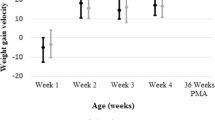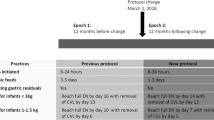Abstract
OBJECTIVE: The purpose of this study was to determine the impact of introducing a high-nutrient transitional formula (TF) for use after discharge on the growth and development of premature infants.
STUDY DESIGN AND METHODS: This was a cohort study of all surviving infants with a birth weight ≤1250 g admitted to the neonatal intensive care unit between January 1, 1995 and December 31, 1996. Infants with major congenital abnormalities were excluded. There were 180 infants discharged, including 66 on TF and 114 on standard formulas for full-term infants.
RESULTS: Use of TF started the week before discharge, and increased from 10% in 1995 to 66% in 1996 (p<0.001). Regression analyses controlling for multiple confounders identified TF as a significant contributor to improved weight at 3 months and length at 18 months. Bayley developmental scores were not affected.
CONCLUSION: Introduction of a TF for very-low-birth-weight infants resulted in improved growth after discharge.
This is a preview of subscription content, access via your institution
Access options
Subscribe to this journal
Receive 12 print issues and online access
$259.00 per year
only $21.58 per issue
Buy this article
- Purchase on Springer Link
- Instant access to full article PDF
Prices may be subject to local taxes which are calculated during checkout


Similar content being viewed by others
References
American Academy of Pediatrics Committee on Nutrition. Nutritional Needs of the Preterm Infant In: Kleinman RE, editor. Pediatric Nutrition Handbook, fourth edition Elk Grove Village, IL: Academy of Pediatrics 1998 55–87
Wilson DC, Cairns P, Halliday HL, Reid M, McClure G, Dodge JA . Randomised controlled trial of an aggressive nutritional regimen in sick very low birthweight infants Arch Dis Child Fetal Neonat Ed 1997 77: F4–11
Carlson SJ, Ziegler EE . Nutrient intakes and growth of very low birth weight infants J Perinatol 1998 18: 252–8
Embleton NE, Pang N, Cooke RJ . Postnatal malnutrition and growth retardation: an inevitable consequence of current recommendations in preterm infants Pediatrics 2001 107: 270–3
Berry MA, Conrod H, Usher RH . Growth of very premature infants fed intravenous hyperalimentation and calcium supplemented formula Pediatrics 1997 100: 647–53
Ehrenkranz RA, Younes N, Lemons JA et al. Longitudinal growth of hospitalized very low birth weight infants Pediatrics 1999 104: 280–9
Dusick A, Vohr BR, Steichen J, Wright LL, Mele L, Verter J for the NICHD Neonatal Research Network Follow-Up Study. Factors affecting growth outcome at 18 months in ELBW infants Pediatr Res 1998 43: 213A
Carver JD, Wu PYK, Hall RT et al. Growth of preterm infants fed nutrient-enriched or term formula after hospital discharge Pediatrics 2001 107: 683–9
Lucas A, Gore SM, Cole TJ et al. A multi-center trial on the feeding of low birth weight infants: effects of diet on early growth Arch Dis Child 1984 59: 722–30
Lucas A, Bishop NJ, King FJ, Cole TJ . Randomized trial of nutrition for preterm infants after discharge Arch Dis Child 1992 67: 324–7
Bayley N . Bayley Scales of Infant Development II San Antonio, TX: Psychological Corporation 1993
Hollingshead AB . Four-Factor Index of Social Status New Haven, CT: Yale University Press 1975
Friel JK, Andrews WL, Matthew JD, McKim E, French S, Long DR . Improved growth of very low birthweight infants Nutr Res 1993 13: 611–20
Lucas A, Morley R, Cole TJ . Randomized trial of early diet in preterm babies later intelligence quotient BMJ [Br Med J] 1998 317: 1481–7
Wheeler RE, Hall RT . Feeding of premature infant formula after hospital discharge of infants weighing less than 1800 grams at birth J Perinatol 1996 16: 111–6
Cooper PA, Rothberg AD, Daview VA et al. Three year growth and development follow-up of very low-birth-weight infants fed own mothers milk, a premature infant formula, or one of two standard formulas J Pediatr Gastroenterol Nutr 1989 8: 348–54
Hediger ML, Overpeck MD, Kuczmarski RJ, McGlynn A, Maurer KR, Davis WW . Muscularity and fatness of infants and young children born small- or large-for-gestational age Pediatrics 1998 102: e60
Strauss RS, Dietz WH . Effects of intrauterine growth retardation in premature infants on early childhood growth J Pediatr 1997 130: 95–102
Georgieff MK, Mills MM, Zempel CE, Chang PN . Catch-up growth, muscle and fat accretion, and body proportionality of infants one year after newborn intensive care J Pediatr 1989 114: 288–92
Brunton JA, Saigal S, Atkinson SA . Growth and body composition in infants with bronchopulmonary dysplasia up to 3 months corrected age: a randomized trial of a high-energy nutrient-enriched formula fed after hospital discharge J Pediatr 1998 133: 340–5
Bishop NJ, King FJ, Lucas A . Increased bone mineral content of preterm infants fed with nutrient enriched formula after discharge from hospital Arch Dis Child 1993 68: 573–8
Ernst JA, Bull MJ, Rickard KA, Brady MS, Lemons JA . Growth outcome and feeding practices of the very low birth weight infant (less than 1500 grams) within the first year of life J Pediatr 1990 117: S156–66
Lucas A, Morley RM, Cole TJ et al. Breast milk and subsequent intelligence quotient in children born preterm Lancet 1992 339: 261
Lucas A, Morley RM, Cole TJ, Gore SM . A randomized multicenter study of human milk versus formula and later development in preterm infants Arch Dis Child 1994 71: 288
Schanler RJ, Burns PA, Abrams SA, Garza C . Bone mineralization outcomes in human milk-fed preterm infants Pediatr Res 1992 31: 583
Schanler RJ, Abrams SA . Postnatal attainment of intrauterine macro mineral accretion rates in low birth weight infants fed fortified human milk J Pediatr 1995 126–441
Lucas A, Fewtrell MS, Morley R et al. Randomized trial of nutrient-enriched formula versus standard formula for postdischarge preterm infants Pediatrics 2001 108: 703–11
Author information
Authors and Affiliations
Rights and permissions
About this article
Cite this article
Worrell, L., Thorp, J., Tucker, R. et al. The Effects of the Introduction of a High-Nutrient Transitional Formula on Growth and Development of Very-Low-Birth-Weight Infants. J Perinatol 22, 112–119 (2002). https://doi.org/10.1038/sj.jp.7210680
Published:
Issue Date:
DOI: https://doi.org/10.1038/sj.jp.7210680
This article is cited by
-
Very preterm infants who receive transitional formulas as a complement to human milk can achieve catch-up growth
Journal of Perinatology (2019)



